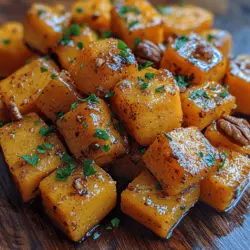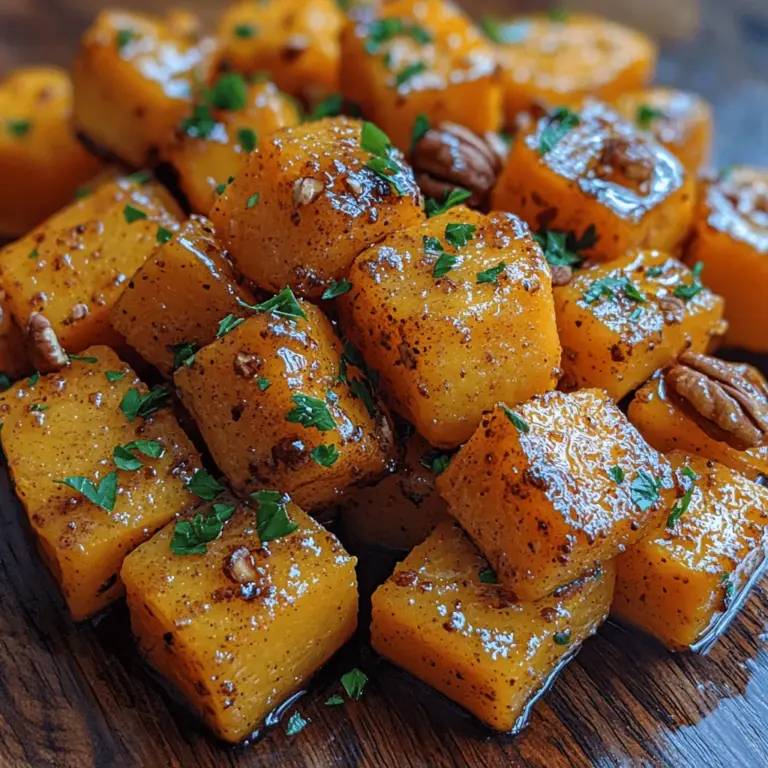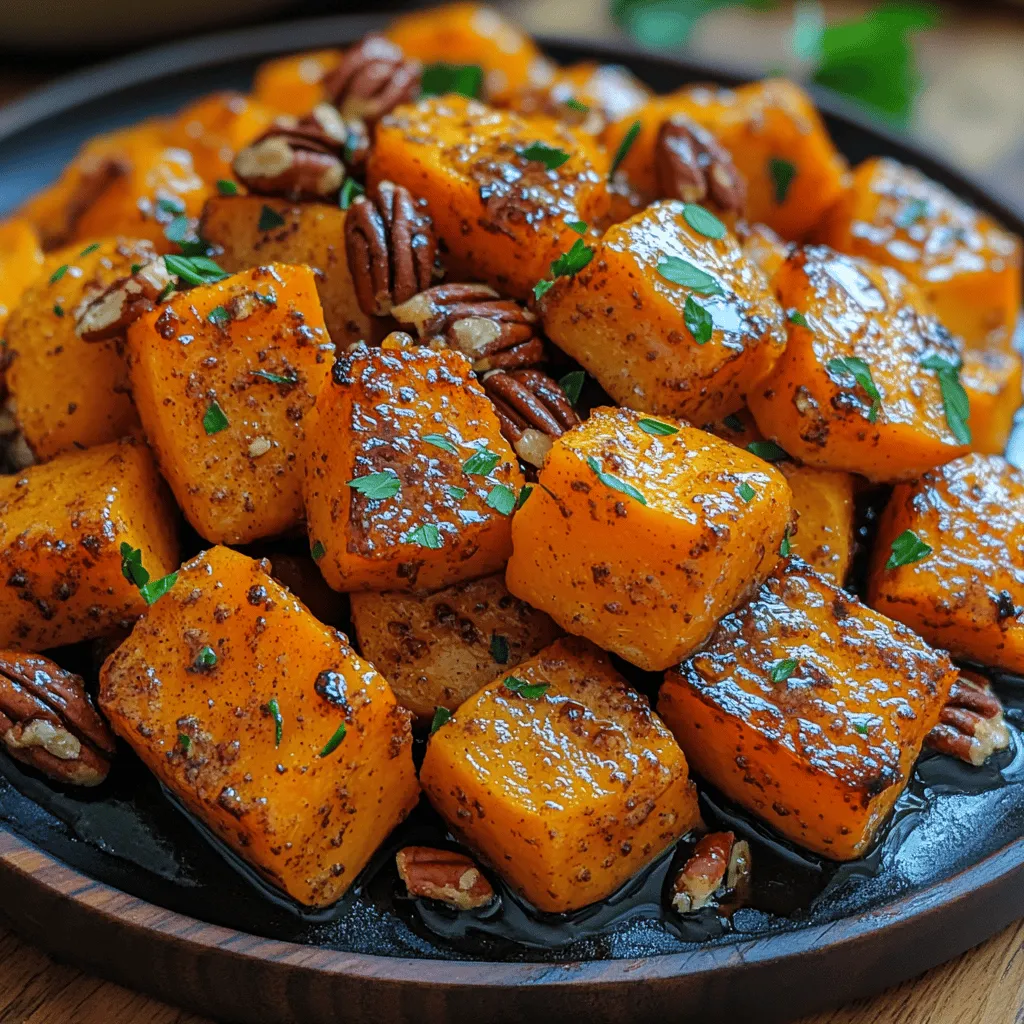Introduction
As autumn rolls in, the vibrant hues of butternut squash grace markets and kitchens alike, capturing the essence of the season. This versatile vegetable, with its smooth, pale orange skin and sweet, creamy flesh, has become a staple in many fall-inspired recipes. Among these, the Sweet & Savory Honey Roasted Butternut Squash stands out as a delightful dish that perfectly balances the natural sweetness of the squash with rich, savory flavors, making it suitable for various occasions—from cozy family dinners to festive holiday feasts.
This recipe is not only easy to prepare but also highlights butternut squash’s unique flavor profile. The caramelization achieved during roasting enhances its sweetness, while honey and spices amplify this effect, creating a dish that is both comforting and sophisticated. Whether served as a side dish, tossed into salads, or enjoyed as a warm, nourishing snack, this honey roasted butternut squash recipe is a must-try for anyone looking to embrace the seasonal bounty.
Understanding Butternut Squash
Butternut squash (Cucurbita moschata) is a winter squash that is beloved for its unique appearance and delicious flavor. This pear-shaped vegetable boasts a smooth, tan skin and a vibrant orange flesh that is rich in nutrients. When cooked, butternut squash has a sweet, nutty taste that lends itself well to both savory and sweet dishes. It’s no wonder that it has become a favorite in kitchens across the globe, especially during the colder months.
Nutritional Benefits
Not only is butternut squash delicious, but it is also packed with vitamins and minerals. A single serving is an excellent source of vitamin A, providing more than 400% of the daily recommended intake. This vitamin is crucial for maintaining healthy vision, skin, and immune function. Butternut squash is also rich in vitamin C, potassium, and dietary fiber, making it a nutritious addition to any meal.
Seasonal Availability
Butternut squash is typically available from late summer through early spring, with peak season occurring in the fall. Its natural sweetness develops during this time, making it an ideal ingredient for hearty, warming dishes. As the weather cools, incorporating butternut squash into your meals can enhance both flavor and nutrition, making it perfect for soups, stews, and roasted vegetable medleys.
Incorporating Butternut Squash into Meals
There are countless ways to enjoy butternut squash beyond roasting. It can be puréed into creamy soups, added to risottos for a touch of sweetness, or even blended into smoothies for a nutrient boost. Additionally, it can be diced and sautéed with other seasonal vegetables or used as a filling for pasta or ravioli. Its versatility makes butternut squash a valuable ingredient in various culinary traditions, appealing to both savory and sweet palates alike.
Ingredients Breakdown
To create the perfect Sweet & Savory Honey Roasted Butternut Squash, you’ll need a few key ingredients that work harmoniously to enhance the natural flavors of the squash.
Detailed Ingredient List
– Butternut Squash: The star of the dish, butternut squash provides a sweet and creamy base that caramelizes beautifully when roasted. Its nutritional profile, rich in vitamins A and C, makes it a healthy choice for any meal.
– Honey: This natural sweetener not only adds depth and richness to the dish but also brings a hint of floral notes that pair perfectly with the squash. Honey is known for its antioxidant properties and can provide a quick energy boost.
– Olive Oil: Essential for roasting, olive oil helps to achieve that golden-brown exterior while also adding healthy fats to the dish. Rich in monounsaturated fats, olive oil contributes to heart health and is a staple in Mediterranean diets.
– Spices: The inclusion of warm spices like cinnamon and nutmeg elevates the flavor profile of the roasted squash. Cinnamon offers a sweet warmth, while nutmeg adds a slightly nutty and aromatic note. Both spices are known for their anti-inflammatory properties and can aid digestion.
– Seasonings: A sprinkle of sea salt and black pepper enhances the natural flavors of the squash, balancing the sweetness with a touch of savory depth. Sea salt can enhance the overall taste, while black pepper adds a mild heat that rounds out the dish.
– Balsamic Vinegar (optional): For those looking to introduce a tangy element, a drizzle of balsamic vinegar can add a delightful contrast to the sweetness of the honey and squash. It also contributes a depth of flavor that can elevate the dish further.
– Nuts: Chopped pecans or walnuts can be sprinkled on top before serving to add crunch and a nutty flavor. These nuts are not only delicious but also provide additional protein, healthy fats, and fiber.
– Fresh Herbs: Garnishing with fresh herbs, such as thyme or rosemary, not only enhances the presentation of the dish but also adds a burst of fresh flavor. Herbs are packed with antioxidants and can provide various health benefits.
Preparation Steps
Now that you have a clear understanding of the ingredients and their roles, it’s time to prepare your Sweet & Savory Honey Roasted Butternut Squash. Follow these essential steps to set the foundation for a delicious and beautifully roasted dish.
Preheating the Oven
The first step in preparing the butternut squash is to preheat your oven to 400°F (200°C). Preheating is crucial for achieving the desired roasting temperature, which helps caramelize the sugars in the squash, resulting in a tender, flavorful dish. A properly preheated oven ensures that the squash cooks evenly and develops that coveted golden-brown exterior.
Preparing the Butternut Squash
Next, you’ll need to prepare the butternut squash for roasting. Here’s a step-by-step guide to help you peel and cut it safely and efficiently:
1. Choose a good-quality squash: Look for a butternut squash that feels heavy for its size and has a uniform tan color without blemishes or soft spots.
2. Wash the squash: Rinse the squash under cold water to remove any dirt or debris, then pat it dry.
3. Peeling the squash: To peel the squash, use a sharp vegetable peeler for the best results. Alternatively, you can use a knife if you feel comfortable. Start at the top and peel away the skin, working your way down, ensuring you remove all the tough outer layer.
4. Cutting the squash: Once peeled, cut the butternut squash in half lengthwise. This will expose the seeds inside. Use a spoon to scoop out the seeds and any stringy flesh. After cleaning out the insides, cut the squash into evenly sized cubes (about 1-inch in size). This ensures even cooking and caramelization during roasting.
By following these steps, you’ll have perfectly prepared butternut squash ready for roasting. The next phase will involve seasoning and cooking, which will bring out the flavors you’ve chosen to enhance this delicious vegetable. Whether you enjoy the sweet and savory notes as a side dish, topping for salads, or even as a standalone snack, your honey roasted butternut squash is sure to impress.


